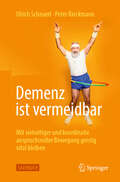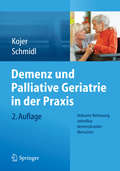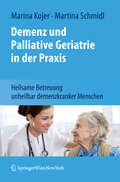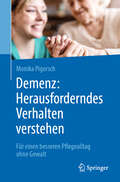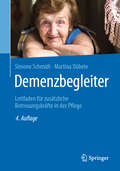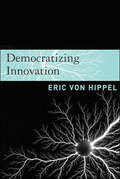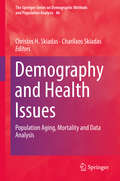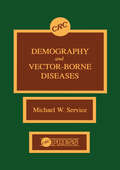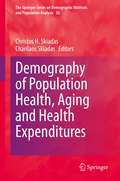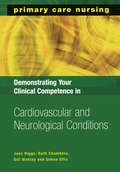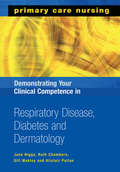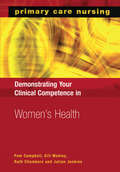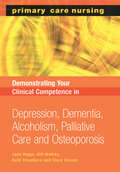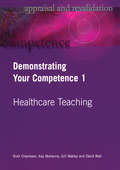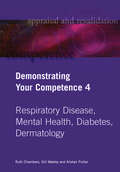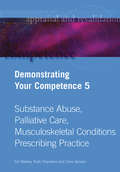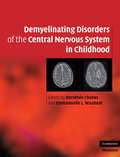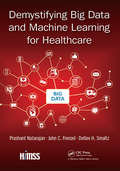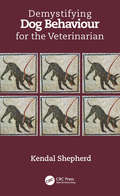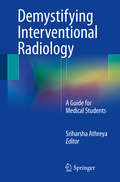- Table View
- List View
Demenz als Störfaktor?: Die Auswirkungen des professionellen Habitus auf die interprofessionelle Versorgung von Demenzkranken im Krankenhaus (Vallendarer Schriften der Pflegewissenschaft #14)
by Jörg KurmannVor dem Hintergrund einer alternden Gesellschaft sehen sich die Krankenhäuser nicht nur mit immer älteren Patienten, sondern auch mit einem Wandel des Krankheitspanoramas konfrontiert. Mittlerweile ist der größte Anteil aller Patienten über 65 Jahre alt und hat eine oder mehrere chronische Erkrankungen. Diese Veränderungen bedingen eine Neuausrichtung der Krankenbehandlung in den Krankenhäusern. Eine besondere Rolle scheint dabei die Demenz unter den chronischen Erkrankungen einzunehmen. Sie gilt als Störfaktor im Akutkrankenhaus. Der Autor geht diesem Phänomen mithilfe der Habitustheorie und der Systemtheorie, nach, um herauszuarbeiten, warum sich das System Krankenhaus aus seiner Sicht nicht ausreichend diesen neuen Herausforderungen annimmt. Besonders wird dabei das Zusammenspiel der Mediziner und der Pflegenden bei der Versorgung von Menschen mit einer Demenz im Akutkrankenhaus betrachtet. Die Metaphernanalyse hilft in diesem Zusammenhang, die inneren Denkmuster der beiden Professionen darzulegen und kann erste Erklärungsmöglichkeiten für die fehlende Orientierung bieten.
Demenz im Film: Wie das Kino vergessen lernte
by Dennis HenkelSeit der Jahrtausendwende wagen Filmemacher immer häufiger, das gesellschaftlich drängende Thema Demenz in Großproduktionen aufzugreifen - für die große Leinwand mit ihren hochbudgetierten Produktionen war das bis dahin zu brenzlig, kontrovers und für Kassenschlager schlicht ungeeignet. Der Trend setzt sich bis heute fort: Allein 2020 schafften es sechs Großproduktionen um das Thema Demenz, teils mit Hollywoodstars besetzt, in die großen Kinosäle. Das Kino lernt also Vergessen! Die Autoren begeben sich in diesem Buch auf die Spuren dieser Entwicklung und heben gesellschaftlich und künstlerisch bemerkenswerte Aspekte hervor: Sie skizzieren die Perspektive der Erkrankten, der Angehörigen und die filmische Darstellung von Pflegeeinrichtungen. Filme weiblicher Regisseure und Werke aus anderen Kulturen fügen eine antipatriarchische und internationale Sichtweise auf die Erkrankung hinzu und zeigen Standpunkte jenseits stereotyper Vorstellungen auf. Darüber hinaus stellen die Autoren Filme vor, die das Thema “Demenz” mit weiteren umstrittenen Themen verbinden, wie z. B. der Homosexualität. Diese nutzen die Kraft der Fiktion, um uns zukünftige Weltentwürfe zu zeigen, in denen z. B. künstliche Intelligenz und futuristische Techniken Dementen das Leben erleichtern. Das Buch möchte so auf unterhaltsame Weise einen Beitrag zur Aufklärung über Demenz leisten und auch sensibilisieren für die künstlerisch-filmische Aufbereitung einerseits und medizinische Realität andererseits. Es richtet sich an alle kinobegeisterten Leser, ob mit oder ohne medizinisch-fachliche Vorkenntnisse - für unvergessliche Einblicke in das Thema “Demenz im Film”!
Demenz ist vermeidbar: Mit vielseitiger und koordinativ anspruchsvoller Bewegung geistig vital bleiben
by Ulrich Scheuerl Peter RieckmannWer seinen Körper durch vielseitige Bewegung regelmäßig auf Trab hält, kann das Demenz- und Alzheimerrisiko reduzieren. Das Buch eines ambitionierten Rentners und eines international anerkannten Neurologen mit Schwerpunkt Hirngesundheit widmet sich diesem wichtigen Präventionsthema. Zu Beginn führen vier Kapitel in die Theorie der Demenzvermeidung ein und erläutern, warum koordinative Bewegung für die Erneuerung des Gehirns so wichtig ist. Die nächsten Abschnitte widmen sich der praktischen Umsetzung von unterschiedlichen körperlichen Aktivitäten. Es werden eine große Auswahl von Übungen sowie sportliche Maßnahmen für motivierte Anfänger oder bereits ambitionierte Sportler vorgestellt. Besonders berücksichtigt werden Personen, denen Bewegung schwer fällt oder die erste Anzeichen von Demenz verspüren. Mit dieser Anleitung kann ein aktiver Lebensstil leicht nachgeahmt werden. Ganz genau nach dem Credo des Buches: Nur altersgemäßer Ausdauersport, wie Radfahren oder Walking ist zu wenig, er stärkt zwar Herz und Kreislauf, fordert aber zu wenig das Gehirn. Ein Praktiker der Bewegung und ein Kenner des Gehirns haben gemeinsam aufgeschrieben, wie man durch gezielte Bewegung das Gehirn im Alter gesund erhalten kann, selbst wenn man seinen grauen Zellen im Leben einiges zugemutet hat. Das Buch will motivieren sich vielseitig und gezielt zu bewegen und richtet sich an Menschen unterschiedlichen Alters, die mit abwechslungsreicher Bewegung und anderer Aktivitäten geistig vital bleiben wollen.
Demenz und Palliative Geriatrie in der Praxis
by Martina Schmidl Marina KojerBei fortgeschrittener Demenz wird die Schmerztherapie oft ausschließlich als Aufgabe für die Zeit des Sterbens gesehen. Dabei sind demenzkranke Hochbetagte meistens lange vorher palliativbedürftig. Die Autorinnen - beide haben langjährige Erfahrung in der Betreuung demenzkranker Hochbetagter - definieren Schlüsselthemen wie Kommunikation, Schmerz, Ernährung und Ethik für diese Patientengruppe neu. Sie liefern Hinweise zur Umsetzung ihres Konzepts in der stationären Langzeitbetreuung und beziehen Angehörige und Betreuer in ihre Betrachtung mit ein.
Demenz und Palliative Geriatrie in der Praxis: Heilsame Betreuung unheilbar demenzkranker Menschen
by Martina Schmidl Marina Kojer Katharina HeimerlGute Lebensqualität für demenzkranke HochbetagteDemenz ist unheilbar, die Diagnose besiegelt den Verlauf. Daher brauchen Demenzkranke bereits lange vor dem Tod palliative Betreuung. Gute Lebensqualität für Demenzkranke bedeutet vor allem menschliche Zuwendung. Die Kunst der mitfühlenden Kommunikation, das „Berührbarsein“, ist ein wesentlicher Teil der Symptomkontrolle. Erst durch eine lebendige Beziehung zu den Kranken und „einem Gefühl“ für ihr Verhalten kann Hilfe wirksam, können „gute“ Entscheidungen getroffen werden. Die Autorinnen und Autoren haben jahrzehntelange Erfahrung in der palliativen Betreuung demenzkranker Hochbetagter und geben ihr Know-how mit einem hohen Maß an Empathie und Wertschätzung weiter. Sie setzen sich dabei unter anderem mit Fragen der Kommunikation, der Symptomlinderung und mit ethischen Aspekten auseinander. Die dritte Auflage wurde aktualisiert und mit neuen Kapiteln zu aktuellen Themen erweitert, wie z. B. Beziehungsgestaltung und Demenz im Krankenhaus bzw. in der ambulanten Pflege.Inhalt:Kommunikation als geriatrische SymptomkontrolleSymptomkontrolle bei Schmerzen, Essstörungen, Multimorbidität und Gebrechlichkeit sowie in der letzten LebensphaseMenschenrechteMenschenbild und HaltungEthikAngehörigeDemenzkranke Menschen in der ambulanten Pflege und im Krankenhaus
Demenz und Palliative Geriatrie in der Praxis: Heilsame Betreuung unheilbar demenzkranker Menschen
by Marina Kojer and Martina SchmidlBei fortgeschrittener Demenz wird die Schmerztherapie oft ausschließlich als Aufgabe für die Zeit des Sterbens gesehen. Dabei sind demenzkranke Hochbetagte meistens lange vorher palliativbedürftig. Die Autorinnen – beide haben langjährige Erfahrung in der Betreuung demenzkranker Hochbetagter – definieren Schlüsselthemen wie Kommunikation, Schmerz, Ernährung und Ethik für diese Patientengruppe neu. Sie liefern Hinweise zur Umsetzung ihres Konzepts in der stationären Langzeitbetreuung und beziehen Angehörige und Betreuer in ihre Betrachtung mit ein.
Demenz: Für einen besseren Pflegealltag ohne Gewalt
by Monika PigorschIn der Pflege -und Betreuung von Menschen mit Demenz gibt es immer wieder Situationen, die schwierig sind. Ein solches Verhalten ist meist eine Aufforderung an das soziale Umfeld, ein Hilferuf, der viele Gesichter hat. Dieses Buch widmet sich diesem wichtigen Pflegethema. Die erfahrene Autorin zeigt praxisorientiert mit vielen Fallbeispielen auf, wie sich herausforderndes Verhalten im Pflegealltag bei Demenzerkrankten zeigt, wie es vorgebeugt werden kann und welche Maßnahmen sich zur Deeskalation eignen. Viele Konflikte können vermieden werden, wenn wir nicht die Krankheit in den Fokus stellen, sondern den Menschen mit seinen noch vorhandenen Bedürfnissen und Fähigkeiten wahrnehmen. An vielen Beispielen wird deutlich, nur wenn Lebensqualität erhalten bleibt, kommt es zu weniger herausforderndem Verhalten und gewaltsamen Situationen. Davon profitieren die erkrankten Menschen aber auch die Menschen, die sie betreuen und pflegen. Viele hilfreiche Tipps und ein Wahren der Würde und Persönlichkeit des Menschen mit Demenz führen zu einem entspannteren Miteinander. Das Buch richtet sich in erster Linie an alle Mitarbeitenden in Gesundheitsberufen, die in der Pflege und Betreuung von Demenzerkrankten stationär oder ambulant eingebunden sind. Aber auch Angehörige werden darin viel wertvolles Wissen erhalten.
Demenzbegleiter: Leitfaden für zusätzliche Betreuungskräfte in der Pflege
by Simone Schmidt Martina DöbeleDas erfolgreiche Buch für zusätzliche Betreuungskräfte jetzt in aktualisierter 4. Auflage. Betreuungskräfte übernehmen eine wichtige Aufgabe in der Betreuung und Begleitung von Menschen mit Demenz und tragen zur Verbesserung der individuellen Lebenssituation bei. Dieses Handbuch unterstützt nicht nur Alltagsbegleiter, sondern auch Ehrenamtliche und professionell Pflegende bei ihrer sinnstiftenden und anspruchsvollen Aufgabe. Verständlich werden alle wichtigen Grundlagen erläutert, um demenzerkrankten oder psychisch veränderten Menschen zu helfen, ihren Alltag zu bewältigen. Erfahren Sie mehr über: Krankheitslehre, Alltagsgestaltung und Beschäftigungsangebote, Betreuungsqualität, Erste Hilfe in schwierigen Situationen, Hauswirtschaft. Das Buch ist auf alle Inhalte der Fortbildung zur zusätzlichen Betreuungskraft nach § 87b SGB XI abgestimmt. Zusätzlich gibt es Tipps und Checklisten für das Praktikum, zur Reflexion und Selbstpflege. Für Betreuungskräfte in der Fortbildung und Praxis, und für alle Personen, die Menschen mit Demenz oder eingeschränkter Alltagskompetenz begleiten.
Democracy, Civil Society, and Health in India
by Madhvi Gupta PushkarIndia's health failures remain visible and pronounced despite high rates of economic growth since the 1980s and more than six decades of democratic rule. The authors address the key issues that emerge from the country's health situation, speculating on what it will take for low-income groups to begin claiming for better social services
Democratizing Innovation: Reproductive Health And The Environment (The\mit Press Ser.)
by Eric Von HippelThe process of user-centered innovation: how it can benefit both users and manufacturers and how its emergence will bring changes in business models and in public policy.Innovation is rapidly becoming democratized. Users, aided by improvements in computer and communications technology, increasingly can develop their own new products and services. These innovating users—both individuals and firms—often freely share their innovations with others, creating user-innovation communities and a rich intellectual commons. In Democratizing Innovation, Eric von Hippel looks closely at this emerging system of user-centered innovation. He explains why and when users find it profitable to develop new products and services for themselves, and why it often pays users to reveal their innovations freely for the use of all.The trend toward democratized innovation can be seen in software and information products—most notably in the free and open-source software movement—but also in physical products. Von Hippel's many examples of user innovation in action range from surgical equipment to surfboards to software security features. He shows that product and service development is concentrated among "lead users," who are ahead on marketplace trends and whose innovations are often commercially attractive.Von Hippel argues that manufacturers should redesign their innovation processes and that they should systematically seek out innovations developed by users. He points to businesses—the custom semiconductor industry is one example—that have learned to assist user-innovators by providing them with toolkits for developing new products. User innovation has a positive impact on social welfare, and von Hippel proposes that government policies, including R&D subsidies and tax credits, should be realigned to eliminate biases against it. The goal of a democratized user-centered innovation system, says von Hippel, is well worth striving for. An electronic version of this book is available under a Creative Commons license.
Demographic Changes, a View from California: Implications for Framing Health Disparities
by Institute of Medicine of the National AcademiesThe IOM held a workshop on July 28, 2008, to examine strategies for discussing health disparities in ways that engage the public and motivate change. Speakers focused on health disparities in California, which continues to see dramatic demographic shifts.
Demography and Health Issues: Population Aging, Mortality And Data Analysis (The\springer Series On Demographic Methods And Population Analysis Ser. #46)
by Christos H. Skiadas Charilaos SkiadasThis book provides new theories, applications and quantitative methods in demography, population studies and statistics. It presents and applies data analysis, statistics and stochastic modeling techniques focusing on demography, population aging, mortality and health sciences. The book describes diverse stochastic processes as well as Markov and semi-Markov models in demography and population studies, along with chapters on statistical models and methods in biostatistics and epidemiology. As such the book will be a valuable source to demographers, health scientists, statisticians, economists and sociologists.
Demography and Vector-Borne Diseases
by Michael W. ServiceAn in-depth overview on the demo-graphic changes occurring world-wide and the repercussions this is having on the pattern of vector-borne disease is pre-sented in this book. Internationally recognized scientists, epidemiologists, entomologists, parasitologists, and ecologists are contributing authors to this comprehensive account.
Demography of Population Health, Aging and Health Expenditures (The Springer Series on Demographic Methods and Population Analysis #50)
by Christos H. Skiadas Charilaos SkiadasThis book provides theoretical and applied material for estimating vital parts of demography and health issues including the healthy aging process along with calculating the healthy life years lost to disability. It further includes the appropriate methodology for the optimum health expenditure allocation. Through providing data analysis, statistical and stochastic methodology, probability approach and important applications, the book explores topics such as aging and mortality, birth-death processes, self-perceived age, life-time and survival as well as pension and labor-force. By providing a methodological approach to health problems in demography and society including and quantifying important parameters, this book is a valuable guide for researchers, theoreticians and practitioners from various disciplines.
Demonstrating Your Clinical Competence in Cardiovascular and Neurological Conditions
by Simon Ellis Ruth Chambers Gill Wakley Jane HiggsAll registered nurses are required to keep portfolios which demonstrate their competence in clinical practice in order to receive re-registration with the Nursing and Midwifery Council. In addition, they are encouraged to seek individual annual appraisals which highlight their progress and areas the require development. This book provides examples and ideas on how to document learning, competence, performance or standards of service delivery. It takes an important clinical theme throughout, providing key information on clinical management from the outset, followed by structured examples of evidence of performance and application of learning in practice, individualised for each clinical theme, focussing on cardiovascular and neurological conditions. It explains how to gather evidence from clinical interactions and other aspects of daily work. All nurses working in primary care with an interest in chronic disease management, especially those who are looking for a more ‘first contact’ work within their role will find this book valuable reading.
Demonstrating Your Clinical Competence in Respiratory Disease, Diabetes and Dermatology
by Ruth Chambers Gill Wakley Jane Higgs Alistair PullanEvidence-based medicine draws on terminology used in biostatistics epidemiology health economics philosophy ethics logic and the social sciences. In this unique compendium the author defines the common terms used in evidence-based medicine and provides useful notes and references to help the reader understand this terminology and explore further if necessary. The book explains statistical formulae commonly used in evidence-based medicine. It is ideal for doctors nurses and pharmacists who are not familiar with statistical terms and statisticians and health economists who are not familiar with pharmaceutical or clinical terminology. The definitions explanatory notes and references are clear and easily understandable.
Demonstrating Your Clinical Competence in Women's Health
by Pam Campbell Ruth Chambers Gill Wakley Julian JenkinsPrimary Care Nursing Series. All registered nurses are required to keep portfolios which demonstrate their competence in clinical practice in order to receive re-registration with the Nursing and Midwifery Council. In addition, they are encouraged to seek individual annual appraisals which highlight their progress and areas the require development. This book provides examples and ideas on how to document learning, competence, performance or standards of service delivery. Presented in an easy-to-read style, with practical suggestions to improve clinical care, it enables readers to expand their clinical knowledge as well as enabling them to demonstrate their level of expertise through portfolio work, focusing on the area of women’s health. It highlights the most appropriate evidence to prove competency and expertise, and provides the information to identify areas of strength and weakness, suggesting ways in which clinical care can be improved and explains how to gather evidence for clinical interactions and other aspects of daily work. All nurses working in primary care with an interest in women’s health, including practice nurses, health visitors, community midwives, school nurses, district nurses, occupational health nurses and sexual health nurses will find this book essential reading. For more information on other titles in this series please click here
Demonstrating Your Clinical Competence: Depression, Dementia, Alcoholism, Palliative Care and Osteoperosis
by Ruth Chambers Gill Wakley Jane Higgs Clare GeradaThis work is intended for those already in working in community care, including nurses, nursing students and social workers. It is aimed at those who have to provide palliative care from time to time, and at those who are considering a career shift into this field.
Demonstrating Your Competence: v. 1
by Kay Mohanna David Wall Ruth Chambers Gill WakleyThis working manual has been developed to ensure that all health professionals involved in immunization will be both knowledgable about procedures and confident about their benefits. It shows the practitioner how to give vaccines safely and how to inform parents. The book is line with the new and revised "Immunization Against Infectious Disease" produced by the Department of Health, but is written in a practical and easily accessible form. As well as being aimed at general practitioners, health visitors, school health nurses, practice nurses, clinical medical officers and district nurses, the book has been written in such a fashion as to be understandable by parents. It has sections giving answers to the questions most frequently asked by parents, and to the most common problems. In addition, the book is adaptable for local use, with space for key contacts and `phone numbers.
Demonstrating Your Competence: v. 4
by Ruth Chambers Gill Wakley Alistair PullanThis volume, focusing on breast cancer, is part of a survey of health care needs for specific conditions, published on behalf of the Department of Health. This study overall considers questions such as the population's needs, the services available or unavailable to them, the effectiveness of these services, and other perspectives in disease and service areas. This is the second series of needs assessment reviews.
Demonstrating Your Competence: v. 5
by Ruth Chambers Gill Wakley Clare GeradaThis volume, focusing on dermatology, is part of a survey of health care needs for specific conditions, published on behalf of the Department of Health. This study overall considers questions such as the population's needs, the services available or unavailable to them, the effectiveness of these services, and other perspectives in disease and service areas. This is the second series of needs assessment reviews.
Demyelinating Disorders of the Central Nervous System in Childhood
by Dorothée Chabas Emmanuelle L. WaubantAlthough multiple sclerosis and other disorders of myelin formation and repair are most commonly associated with adults, they can also occur in infants, children and adolescents. Up to 5 percent of those with MS experience symptoms before the age of 18, and the number of cases diagnosed is rising. There is a lack of awareness about these diseases in childhood, however, even amongst pediatric neurologists and MS specialists. Demyelinating Disorders of the Central Nervous System in Childhood provides comprehensive coverage of these diseases, highlighting throughout the differences between management in childhood and in adults. With sections dedicated to the diagnosis, course, treatment and biology of pediatric MS, detailed chapters on other childhood demyelinating diseases, including acute disseminated encephomyelitis, optic neuritis, acute complete transverse myelitis and neuromyelitis optica, are also provided. Essential reading for pediatric neurologists and MS specialists, this book will also be valuable reading for adult neurologists and pediatricians.
Demystifying Big Data and Machine Learning for Healthcare
by Detlev H. Smaltz Prashant Natarajan John C. FrenzelHealthcare transformation requires us to continually look at new and better ways to manage insights – both within and outside the organization today. Increasingly, the ability to glean and operationalize new insights efficiently as a byproduct of an organization’s day-to-day operations is becoming vital to hospitals and health systems ability to survive and prosper. One of the long-standing challenges in healthcare informatics has been the ability to deal with the sheer variety and volume of disparate healthcare data and the increasing need to derive veracity and value out of it. Demystifying Big Data and Machine Learning for Healthcare investigates how healthcare organizations can leverage this tapestry of big data to discover new business value, use cases, and knowledge as well as how big data can be woven into pre-existing business intelligence and analytics efforts. This book focuses on teaching you how to: Develop skills needed to identify and demolish big-data myths Become an expert in separating hype from reality Understand the V’s that matter in healthcare and why Harmonize the 4 C’s across little and big data Choose data fi delity over data quality Learn how to apply the NRF Framework Master applied machine learning for healthcare Conduct a guided tour of learning algorithms Recognize and be prepared for the future of artificial intelligence in healthcare via best practices, feedback loops, and contextually intelligent agents (CIAs) The variety of data in healthcare spans multiple business workflows, formats (structured, un-, and semi-structured), integration at point of care/need, and integration with existing knowledge. In order to deal with these realities, the authors propose new approaches to creating a knowledge-driven learning organization-based on new and existing strategies, methods and technologies. This book will address the long-standing challenges in healthcare informatics and provide pragmatic recommendations on how to deal with them.
Demystifying Dog Behaviour for the Veterinarian
by Kendal ShepherdThe behaviour textbook that's been missing! - Dr Mandy Roshier, University of Nottingham, School of Veterinary Medicine and Science, UK This practical guide for busy veterinarians demystifies the apparently complex nature of canine behaviour while simultaneously emphasising its importance. Authored by acclaimed veterinary behaviour consultant Kendal Shepherd, the book provides practical knowledge of dog behaviour and an understanding of how to talk about it with clients. Shepherd shows how this can enhance the relationship between owner and pet and between dog and environment, including the vet surgery, as well as improve the vet’s own sense of fulfilment and enjoyment of practice. From a discussion on the true nature of obedience to stressing the importance of behavioural indicators when assessing pain and mental welfare and finally by reminding vets of their obligations under Dangerous Dogs legislation, the emphasis is on the prevention of aggression throughout. Packed with anecdotes drawn from real-life cases, easy to read and understand, the principles explained can be effortlessly assimilated into the average consultation without the need for lengthy report-writing.
Demystifying Interventional Radiology
by Sriharsha AthreyaThis book is a concise introduction to the interventional radiology field and is designed to help medical students and residents understand the fundamental concepts related to image-guided interventional procedures and determine the appropriate use of imaging modalities in the treatment of various disorders. It covers the history of interventional radiology; radiation safety; equipment; medications; and techniques such as biopsy and drainage, vascular access, embolization, and tumor ablation. The book also describes the indications, patient preparation, post-procedure care, and complications for the most common interventional radiology procedures.


